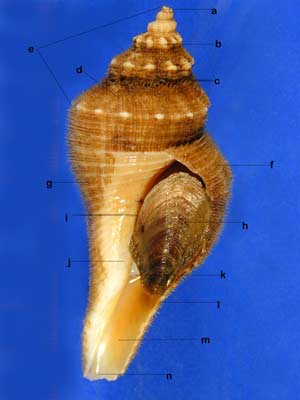![]() General Morphology
General Morphology
![]() Families: Haliotidae,
Strombidae, Buccinidae,
Melongenidae, Volutidae.
Families: Haliotidae,
Strombidae, Buccinidae,
Melongenidae, Volutidae.

Gastropods: shell with body whorl forming almost entire surface, not very compressed.
a. Apex or protoconch
b. Angular whorl
c. Suture
d. Axial sculpture
e. Spire
f. Shoulder
g. Body whorl
h. Operculum
i. Inner lip
j. Columella
k. Aperture
l. Outer lip
m. Siphonal or anterior canal
n. Siphonal notch
Family Haliotidae
Small to large, round to oval, spiral, depressed, ear-shaped, shape with small flattened spire. Large, saucer-shaped body whorl. Surface often with rough axial or spiral lines, ribs or folds. Row of round or oval holes along left margin. Columellar margin thickened and flattened. No operculum. Herbivorous. Attached to intertidal rocks by large muscular, highly edible foot.
Family Strombidae
Mostly medium to large, thick shells with conical, often tall, spire. Large body whorl. Long narrow aperture, usually with stromboid notch through which the eye projects. Outer lip thick, flaring, often wing-like, sometimes with digitations. Siphonal canal ususally extended. Small, narrow, horny, brown, claw-shaped operculum, one edge notched or serrated; used for locomotion, rather than to close the aperture. Herbivorous, feeding on algae and detritus. Found on sand or mud, near coral reefs, in intertidal to shallow waters.
Family Buccinidae
Small to large, thick shells in variable shapes, primarily ovate or fusiform. Tapering spire with pointed apex. Large body whorl. Smooth or with axial ribs and spiral cords. Aperture usually large, with notched base. Columella generally smooth. Siphonal canal usually short. Some deeply umbilicate. With heavy, dark periostracum. Thin, horny, ovate operculum, with apical nuceleus. Carnivorous, primarily scavengers, feeding on bivalves, worms and carrion. Found on hard bottom, in intertidal, shallow to deep waters.
Family Melongenidae
Medium to very large, thick, heavy shells. Form quite variable; often pear-shaped with strongly keeled shoulder and short spire. Large, inflated body whorl. Some with axial ribs and spiral cords, often nodulose or spiny, especially on shoulder. Large aperture, often with flaring outer lip. Siphonal canal mainly wide and extended. Periostracum usually thick, brown. Thick, horny, claw-shaped operculum. Carnivorous, feeding on molluscs or carrion. Mostly found in intertidal to shallow waters.
Family Volutidae
Medium to very large, thick, fusiform or ovate shells. Apex often ended in a large embryonic whorl. Often with nodulose shoulder, axial ribs and spiral threads. Many very colorful, with striking patterns. Large, elongate aperture. Columella usually calloused, with prominent folds. Horny, claw-like operculum, missing in most larger species. Mostly carnivorous, feeding on molluscs and other animals; some are scavengers. Fast-moving, most burrowing in sand, usually in deep waters, but some intertidal, on sand flats.